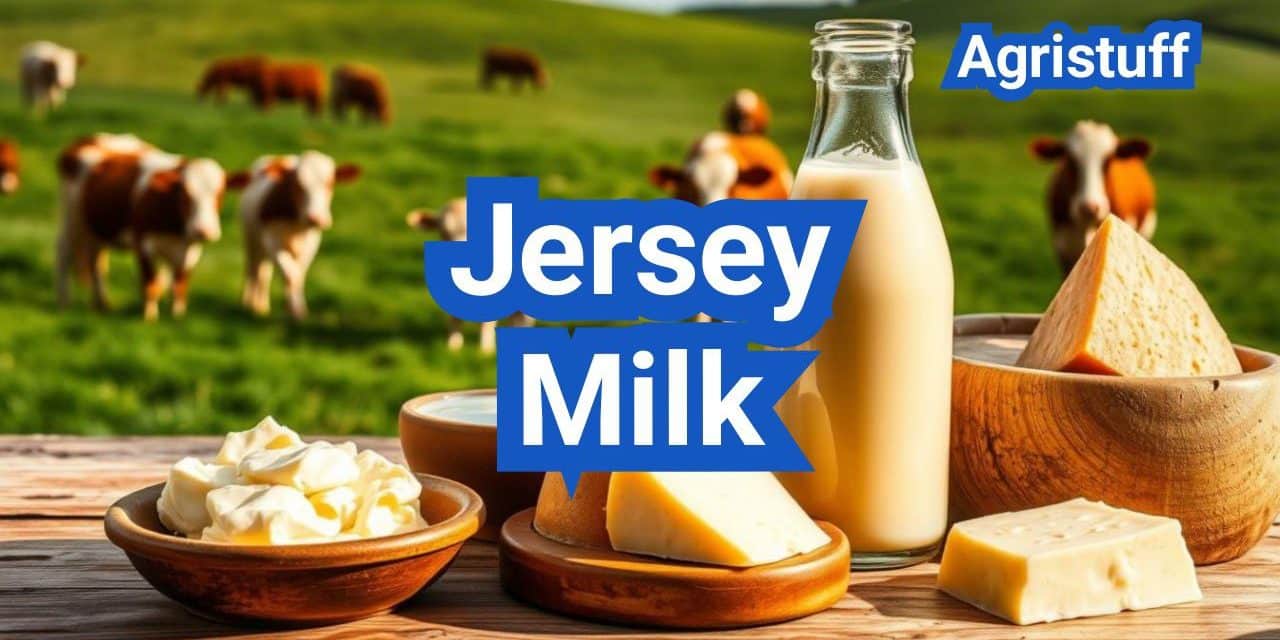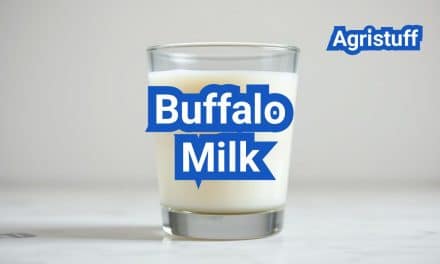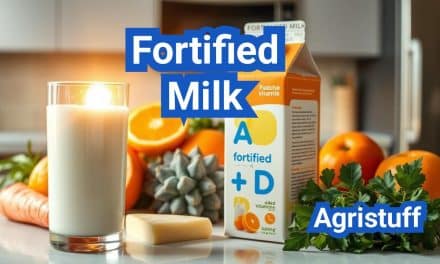The Cadillac of all milk, Jersey milk is renowned for its rich, creamy flavor and elevated nutritional value. Originating from the Jersey cattle breed, this dairy product has gained popularity in the U.S. and USA due to its exceptional qualities.
With a higher butterfat content, Jersey milk is ideal for various dairy products, enhancing their taste and texture. Its unique characteristics make it a preferred choice among consumers seeking premium dairy experiences.
Key Takeaways
- Jersey milk is known for its rich flavor and higher nutritional value.
- The Jersey cattle breed is the source of this premium dairy product.
- Higher butterfat content makes it suitable for various dairy applications.
- Growing popularity in the U.S. and USA due to its exceptional qualities.
- Ideal for producing high-quality dairy products with enhanced taste and texture.
What Makes Jersey Milk Special
With a legacy that spans centuries, Jersey cows produce milk that is both rich and creamy. This heritage is not just about the history of the breed, but also about the unique characteristics that make their milk stand out in the world of dairy farming.
The Rich Heritage of Jersey Cows
Jersey cows have a storied past, originating from the Channel Island of Jersey. Their breed has been carefully preserved, resulting in milk that is not only rich in flavor but also boasts a higher butterfat content compared to other dairy breeds. This rich heritage contributes significantly to the milk’s quality.
The history of Jersey cows dates back to the 18th century when they were first introduced to the United States. Since then, they have been bred to maintain their unique characteristics, making them a favorite among dairy farmers who value quality over quantity.
Distinctive Golden Color and Creamy Texture
One of the most noticeable features of Jersey milk is its distinctive golden color, which is due to its high beta-carotene content. This not only gives the milk its characteristic hue but also enhances its nutritional profile. The creamy texture of Jersey milk makes it ideal for various dairy products, from cheese to ice cream.
- Higher butterfat content for richer flavor
- Enhanced nutritional profile due to its high beta-carotene content
- Ideal for producing high-quality dairy products
In conclusion, the combination of the Jersey cow’s rich heritage and the milk’s distinctive characteristics makes Jersey milk a premium choice for those seeking high-quality dairy products.
Jersey Milk Nutrition Profile

As a nutrient-rich dairy product, Jersey milk offers several health benefits due to its comprehensive nutritional breakdown. This section delves into the specifics of what makes Jersey milk a superior choice for those seeking a more nutritious dairy option.
Comprehensive Nutritional Breakdown
Jersey milk is distinguished by its rich nutritional profile, which includes a higher concentration of essential nutrients compared to average milk. It contains 15% to 20% more protein, making it an excellent choice for individuals looking to increase their protein intake.
The milk also boasts 15% to 18% more calcium and 10% to 12% more phosphorus than regular milk, contributing to stronger bones and teeth. The following table provides a detailed comparison of the nutritional content of Jersey milk versus average milk:
| Nutrient | Jersey Milk | Average Milk |
|---|---|---|
| Protein | Higher by 15%-20% | Standard |
| Calcium | Higher by 15%-18% | Standard |
| Phosphorus | Higher by 10%-12% | Standard |
Higher Protein Content
The elevated protein content in Jersey milk is one of its most significant advantages. Protein is crucial for muscle repair, growth, and overall health. With Jersey milk, consumers can enjoy a more satisfying and nutritious beverage that supports their dietary needs.
Vitamin and Mineral Composition
In addition to its higher protein content, Jersey milk is also rich in vitamins and minerals. It provides essential nutrients that are vital for various bodily functions, from energy production to immune system support. The milk’s rich vitamin and mineral composition makes it a valuable addition to a balanced diet.
Overall, the nutritional profile of Jersey milk underscores its value as a healthier dairy option. Its comprehensive nutritional breakdown, higher protein content, and rich vitamin and mineral composition make it an attractive choice for health-conscious consumers.
Understanding Jersey Milk Butterfat Percentage
Understanding the butterfat content in Jersey milk is crucial for appreciating its rich taste and texture. Jersey milk is known for having a higher butterfat percentage compared to milk from other cow breeds, such as Holsteins.
Average Butterfat Content
The average butterfat content in Jersey milk typically ranges between 4.5% to 5.5%. This is significantly higher than the average butterfat content found in milk from other dairy breeds. For instance, Holstein milk usually contains around 3.5% to 4% butterfat. The higher butterfat content in Jersey milk contributes to its creamy texture and rich flavor, making it ideal for producing high-quality dairy products like cheese, butter, and ice cream.
Seasonal Variations in Butterfat
It’s worth noting that the butterfat content in Jersey milk can vary seasonally. Factors such as the cow’s diet, stage of lactation, and overall health can influence the butterfat percentage. Generally, milk produced during the spring and early summer tends to have a slightly lower butterfat content due to the lush, green pasture available during these seasons. Conversely, milk produced during the winter months may have a higher butterfat content as cows are often fed richer, more concentrated diets.
How Butterfat Affects Taste and Texture
The higher butterfat content in Jersey milk significantly impacts its taste and texture. The increased fat content gives Jersey milk a richer, creamier flavor that is often described as more indulgent and satisfying. Additionally, the higher butterfat content enhances the mouthfeel, making it feel more luxurious and smooth on the palate. This characteristic makes Jersey milk particularly well-suited for producing premium dairy products where flavor and texture are paramount.
In conclusion, the butterfat percentage in Jersey milk is a key factor that distinguishes it from other types of milk. Its higher butterfat content not only enhances the taste and texture but also makes it a preferred choice for various dairy applications.
Jersey Milk vs. Holstein Milk: Key Differences

Understanding the differences between Jersey milk and Holstein milk is crucial for consumers and farmers alike, as it impacts nutritional value, taste, and economic considerations.
Production Volume Comparison
Holstein cows are known for their high milk production volume, making them a popular choice among large-scale dairy farmers. In contrast, Jersey cows produce less milk but with a richer composition.
- Holstein cows: Average production of 8,000-9,000 kg per lactation
- Jersey cows: Average production of 4,000-5,000 kg per lactation
Nutritional Differences
Jersey milk stands out for its higher nutritional content compared to Holstein milk. It contains more protein, calcium, and vitamins, making it a preferred choice for consumers seeking richer dairy products.
| Nutrient | Jersey Milk | Holstein Milk |
|---|---|---|
| Protein | 4.2% | 3.2% |
| Fat | 5.3% | 3.7% |
Taste and Culinary Applications
The richer composition of Jersey milk gives it a creamier texture and more pronounced flavor, ideal for cheese making, butter, and premium ice cream. Holstein milk, while more versatile, lacks the same richness.
Economic Considerations for Farmers
While Holstein cows produce more milk, the higher nutritional value and richer flavor of Jersey milk can command a higher price, potentially offsetting the lower production volume for farmers.
In conclusion, the choice between Jersey and Holstein milk depends on the priorities of the consumer or farmer, whether it’s production volume, nutritional content, or economic return.
The Benefits of A2 Jersey Milk
A2 Jersey milk, derived from Jersey cows, is being recognized for its potential to improve gut health. This type of milk is gaining attention for its unique properties that differentiate it from regular milk.
What Makes A2 Milk Different
A2 Jersey milk contains only the A2 type of beta-casein protein, unlike regular milk which contains both A1 and A2 proteins. Research suggests that the A1 protein may be associated with digestive discomfort in some individuals.
The A2 beta-casein is considered easier to digest, potentially reducing the risk of digestive issues. This characteristic makes A2 Jersey milk an attractive option for those sensitive to regular milk.
Potential Digestive Advantages
Consuming A2 Jersey milk may offer several digestive advantages. Some studies indicate that it can lead to reduced symptoms of bloating, abdominal pain, and other gastrointestinal discomforts associated with A1 milk consumption.
- Easier digestion for sensitive stomachs
- Potential reduction in gastrointestinal discomfort
- May be beneficial for those with milk intolerance
How to Identify and Purchase A2 Jersey Milk
To identify A2 Jersey milk, look for certifications or labels that specify the milk contains only A2 beta-casein protein. Some brands may also provide information on their website or packaging about the type of protein in their milk.
When purchasing A2 Jersey milk, check the packaging for authenticity and consider buying from reputable dairy farms or brands known for their A2 milk products.
By choosing A2 Jersey milk, consumers can potentially enjoy the nutritional benefits of milk with fewer digestive issues.
How to Identify Authentic Jersey Milk Products

Consumers seeking the nutritional benefits of Jersey milk need to know how to identify genuine products. With the increasing popularity of Jersey milk, verifying its authenticity has become crucial for those looking to incorporate this high-quality dairy into their diets.
Reading Labels and Certifications
One of the primary ways to identify authentic Jersey milk is by carefully reading the labels and looking for specific certifications. Consumers should look for the Jersey Cow Milk logo or certifications from reputable dairy organizations. These labels ensure that the milk comes from Jersey cows and meets certain quality standards.
Visual and Taste Characteristics
Authentic Jersey milk is known for its distinctive golden color and creamy texture. When comparing it to other types of milk, Jersey milk typically has a richer appearance. The taste is also notably creamier and more flavorful. Consumers familiar with these characteristics can more easily identify genuine Jersey milk products.
Popular Jersey Milk Brands in the USA
Several brands in the USA specialize in Jersey milk products. Some of the popular ones include brands that explicitly label their products as “Jersey milk” or “100% Jersey cow milk.” Consumers can find these products in specialty grocery stores or directly from local dairy farms that participate in Jersey cow breeding programs.
By understanding how to read labels, recognizing certifications, and being aware of the visual and taste characteristics, consumers can confidently identify authentic Jersey milk products. This knowledge ensures that they reap the nutritional benefits associated with Jersey milk.
Step-by-Step Guide to Cheese Making with Jersey Milk

Cheese making with Jersey milk is a rewarding process that yields delicious and high-quality products. The rich flavor and higher butterfat content of Jersey milk make it an ideal base for a variety of cheeses.
Required Equipment and Ingredients
To start making cheese with Jersey milk, you’ll need specific equipment and ingredients. The essential equipment includes a large pot, cheese mold, cheesecloth, and a thermometer. The ingredients primarily consist of Jersey milk, cheese cultures, and rennet.
The quality of the milk is crucial, so ensure you’re using fresh, high-quality Jersey milk. Cheese cultures and rennet can be sourced from specialty dairy suppliers or online.
Basic Cheese Making Process
The cheese making process involves several key steps:
- Begin by heating the Jersey milk to the appropriate temperature for the specific cheese culture you’re using.
- Add the cheese culture and let it incubate for the required period.
- Rennet is then added to coagulate the milk.
- After coagulation, cut the curds and let them release whey.
- Shape the curds into the desired form using a cheese mold.
- Age the cheese according to the variety’s requirements.
Best Cheese Varieties for Jersey Milk
Jersey milk is versatile and can be used to make a range of cheeses. Some of the best varieties include:
| Cheese Variety | Description | Aging Time |
|---|---|---|
| Cheddar | A popular, versatile cheese with a rich flavor. | 6-12 months |
| Gouda | A mild, creamy cheese suitable for various recipes. | 3-6 months |
| Mozzarella | Ideal for pizzas and caprese salads, with a soft texture. | Short aging or fresh |
These cheese varieties benefit from the unique characteristics of Jersey milk, resulting in rich, flavorful products.
How to Make Premium Ice Cream Using Jersey Milk

With its rich, creamy texture, Jersey milk is the secret ingredient to making exceptional ice cream. The higher butterfat content in Jersey milk compared to other types of milk makes it particularly well-suited for creating a smoother, creamier ice cream.
The Science Behind Creamier Ice Cream
The key to Jersey milk’s ability to produce premium ice cream lies in its composition. The higher butterfat content not only enhances the flavor but also contributes to a smoother texture. This is because the fat molecules in Jersey milk help to reduce the size of ice crystals that form during the freezing process, resulting in a more luxurious mouthfeel.
Basic Jersey Milk Ice Cream Recipe
To make a basic Jersey milk ice cream, you’ll need:
- 2 cups Jersey milk
- 1 cup heavy cream
- 3/4 cup granulated sugar
- 1 tsp vanilla extract
Combine the ingredients in an ice cream maker and churn according to the manufacturer’s instructions.
Flavor Enhancement Tips
To take your Jersey milk ice cream to the next level, consider adding unique flavorings such as:
- Fresh fruit purees
- Nuts or candy pieces
- Spices like cinnamon or nutmeg
Troubleshooting Common Issues
If your ice cream turns out too icy, it may be due to insufficient churning or too much water content. Adjusting the recipe to include more Jersey milk or adding stabilizers like guar gum can help.
Jersey Milk Yogurt: A Complete Production Guide

With its high butterfat content, Jersey milk is ideal for creating yogurt that’s both creamy and delicious. Making yogurt with Jersey milk involves a straightforward process that enhances its natural qualities, resulting in a rich and creamy final product.
Equipment and Ingredients Needed
To start making Jersey milk yogurt, you’ll need a few pieces of equipment and some basic ingredients. The necessary equipment includes a large pot, a thermometer, a yogurt maker or a warm place for incubation, and containers for storing the yogurt.
- A large pot for heating the milk
- A thermometer to monitor temperature
- A yogurt maker or a warm environment for incubation
- Containers for storing the final product
The ingredients are simple: Jersey milk and a yogurt starter culture. You can also add flavorings or sweeteners according to your preference.
Step-by-Step Yogurt Making Process
The process of making yogurt with Jersey milk is relatively simple and involves heating the milk, cooling it, adding the starter culture, and incubating it until it sets.
- Heat the Jersey milk to 180°F (82°C) to kill any bacteria that may be present.
- Cool the milk to 110°F (43°C), the ideal temperature for adding the yogurt starter.
- Add the yogurt starter culture and mix well.
- Incubate the mixture at 100°F (38°C) for 6-8 hours, or until it has set.
- Chill the yogurt in the refrigerator to stop the fermentation process.
Flavor Variations and Add-ins
One of the joys of making your own yogurt is the ability to customize it to your taste. You can add a variety of flavorings or ingredients to create different flavors.
| Flavor | Ingredients |
|---|---|
| Vanilla | Vanilla extract, honey |
| Fruit | Fresh or dried fruits, fruit preserves |
| Nuts | Almonds, walnuts, pecans |
Storage and Shelf Life
Proper storage is crucial to maintaining the quality and safety of your homemade Jersey milk yogurt. Store it in the refrigerator at a temperature below 40°F (4°C).
The shelf life of homemade yogurt is typically up to two weeks when stored properly. Always check for signs of spoilage before consuming.
Working with Cream-Top Jersey Milk

With its distinct natural cream separation, cream-top Jersey milk provides a versatile ingredient for many recipes. This characteristic makes it particularly appealing to chefs and home cooks who value high-quality dairy products.
Understanding Natural Cream Separation
Cream-top Jersey milk is known for its ability to separate into distinct cream and milk layers. This natural process occurs because of the milk’s high fat content and the absence of homogenization. The cream layer is rich in butterfat, making it perfect for whipping or using in recipes where a rich, creamy texture is desired.
How to Incorporate or Separate the Cream
Incorporating the cream into the milk is simple: just shake the bottle gently before use. However, if you want to separate the cream for specific recipes, you can do so by carefully pouring off the cream from the top of the container. This process allows for creative flexibility in both sweet and savory dishes.
To separate the cream effectively, refrigerate the milk for a few hours to allow the layers to settle clearly. Then, carefully pour the cream into a separate container. The remaining milk still retains its rich flavor and can be used in various recipes.
Creative Culinary Uses for the Cream Layer
The separated cream from Jersey milk is incredibly versatile. It can be whipped into a light and airy topping for desserts, or used as a rich addition to soups and sauces. The high butterfat content also makes it ideal for making decadent ice creams and custards.
For a simple yet elegant dessert, try whipping the cream with a bit of sugar and vanilla extract. This makes a delicious topping for fresh fruits or baked goods. You can also use the cream to enrich sauces and gravies, adding a depth of flavor that’s hard to achieve with regular milk.
Where to Find Jersey Milk in the USA

Locating authentic Jersey milk can be a challenge, but several avenues are available for consumers. Jersey milk is prized for its rich flavor and high nutritional value, making it a sought-after choice for many dairy enthusiasts.
National Brands and Distributors
Several national brands now offer Jersey milk or Jersey milk products. These brands often have wide distribution networks, making their products available in major supermarkets across the country. Some notable brands include:
- Organic Valley
- Straus Family Creamery
- Local dairy cooperatives
Local Farm Sources
For those living in rural areas or near dairy farms, purchasing directly from local farms is a viable option. Many Jersey cow farms sell their milk directly to consumers, either through farm stands or delivery services. This option ensures freshness and supports local agriculture.
Farmers Markets and Co-ops
Farmers markets are another excellent place to find Jersey milk. Many dairy farmers sell their products at these markets, providing consumers with fresh, high-quality milk. Additionally, some farmers may offer samples, allowing consumers to taste before they buy.
Online Purchasing Options
The rise of online shopping has made it possible to buy Jersey milk from the comfort of one’s home. Several online retailers and dairy farms offer direct shipping to consumers. This option is particularly convenient for those living in areas where Jersey milk is not readily available in stores.
By exploring these options, consumers can easily find and purchase Jersey milk, enjoying its rich flavor and nutritional benefits.
Jersey Cow Milk Benefits for Sustainable Farming
Jersey cows are emerging as a preferred choice for sustainable dairy farming due to their unique characteristics and benefits. Their ability to produce high-quality milk while maintaining environmentally friendly practices makes them an attractive option for dairy farmers.
Feed Efficiency and Environmental Impact
Jersey cows are known for their feed efficiency, converting feed into milk more effectively than many other breeds. This efficiency reduces the overall environmental impact of dairy farming by minimizing the amount of feed required and subsequently lowering greenhouse gas emissions.
- Lower feed consumption
- Reduced greenhouse gas emissions
- More efficient milk production
Smaller Land Footprint
The smaller size of Jersey cows means they require less land for grazing and housing, making them ideal for small-scale or sustainable farming operations. This smaller land footprint helps preserve natural habitats and biodiversity.
Key benefits include:
- Less land required for grazing
- Preservation of natural habitats
- Potential for more diverse farming systems
Economic Advantages for Small Farms
Raising Jersey cows can be economically advantageous for small farms. Their lower maintenance costs, combined with the premium prices commanded by Jersey milk and dairy products, can improve the profitability of small-scale dairy farming.
“Jersey cows offer a compelling combination of environmental sustainability and economic viability for dairy farmers.”
In conclusion, Jersey cows offer numerous benefits for sustainable farming, from their feed efficiency and smaller land footprint to the economic advantages they provide to small farms. As the dairy industry continues to evolve, the role of Jersey cows in sustainable agriculture is likely to become increasingly important.
How to Store and Handle Jersey Milk Properly

To maintain the rich flavor and nutritional benefits of Jersey milk, proper storage and handling are essential. Jersey milk, known for its high butterfat content and rich nutritional profile, requires careful handling to preserve its quality.
Optimal Storage Conditions
Store Jersey milk in the refrigerator at a temperature below 40°F (4°C). The milk should be kept in its original container or transferred to a clean, airtight container to prevent contamination and exposure to light.
Extending Shelf Life
To extend the shelf life of Jersey milk, it’s crucial to maintain consistent refrigeration. Avoid temperature fluctuations, as they can cause the milk to spoil more quickly. Additionally, keep the milk away from strong-smelling foods, as it can absorb odors easily.
Signs of Spoilage
Check Jersey milk regularly for signs of spoilage. Look for changes in color, texture, or smell. If the milk has curdled, developed an off smell, or shows visible mold, it should be discarded.
Using Jersey Milk Before It Expires
To make the most of your Jersey milk, plan your usage according to its expiration date. Consider using it in various recipes such as cheese making, yogurt production, or as an ingredient in baked goods and desserts. This not only ensures you use the milk before it expires but also allows you to enjoy its rich flavor and nutritional benefits in different ways.
By following these guidelines, you can enjoy Jersey milk at its best while maintaining its quality and safety.
Embracing the Gold Standard of Dairy
Jersey milk stands out as the gold standard in dairy due to its exceptional nutritional benefits and versatility in various dairy products. With its rich profile of proteins, vitamins, and minerals, Jersey milk offers a superior alternative for consumers seeking high-quality dairy.
The higher butterfat content in Jersey milk not only enhances its taste but also makes it ideal for producing premium ice cream, cheese, and yogurt. As consumers become more discerning about the dairy products they consume, embracing Jersey milk can elevate their culinary experiences and provide better nutritional value.
By choosing Jersey milk, individuals can enjoy a range of delicious and nutritious dairy products while supporting sustainable farming practices. As the demand for premium dairy products continues to grow, Jersey milk is poised to remain at the forefront of the industry.
FAQ
What is Jersey milk, and how does it differ from regular milk?
Jersey milk is the milk produced by Jersey cows, known for its rich, creamy texture and higher butterfat content compared to milk from other breeds like Holsteins. This characteristic gives Jersey milk a distinctive golden color and makes it ideal for producing high-quality dairy products.
What are the nutritional benefits of Jersey milk?
Jersey milk is rich in nutrients, including a higher protein content and a richer vitamin and mineral composition. It is particularly high in calcium, vitamins A and D, and other essential nutrients, making it a healthier choice for consumers.
How does the butterfat content in Jersey milk compare to other types of milk?
Jersey milk typically has a higher butterfat content, averaging around 5-6%, compared to Holstein milk, which averages around 3.5-4%. This higher butterfat content contributes to its creamy texture and rich flavor, making it ideal for cheese making, ice cream, and other dairy products.
What is A2 Jersey milk, and what are its benefits?
A2 Jersey milk is produced by Jersey cows that produce only the A2 type of beta-casein protein, as opposed to the A1 type found in milk from many other breeds. A2 milk is believed to be easier to digest for some individuals who experience discomfort with A1 milk, potentially offering digestive advantages.
How can I identify authentic Jersey milk products?
To identify authentic Jersey milk products, look for labels and certifications that indicate the milk is from Jersey cows. Check for visual characteristics like a rich, creamy texture and a golden color. Popular Jersey milk brands in the USA often highlight their use of Jersey milk on their packaging.
Can I make cheese, ice cream, or yogurt with Jersey milk?
Yes, Jersey milk is ideal for making a variety of dairy products, including cheese, ice cream, and yogurt, due to its high butterfat content and rich nutritional profile. Recipes and guides are available for making these products at home, offering a range of flavors and textures.
Where can I find Jersey milk in the USA?
Jersey milk can be found through various sources across the USA, including national brands, local farm sources, farmers markets, and online purchasing options. Consumers can look for products labeled as “Jersey milk” or visit local dairy farms that produce Jersey milk.
What are the benefits of raising Jersey cows for milk production?
Raising Jersey cows for milk production offers several benefits, including their feed efficiency, smaller land footprint, and the economic advantages they provide to small farms. Jersey cows are known for their sustainability and can be a profitable choice for dairy farmers.
How should I store and handle Jersey milk to maintain its quality?
To maintain the quality of Jersey milk, it should be stored in the refrigerator at a consistent, cold temperature. Consumers should check for signs of spoilage, use the milk before it expires, and follow proper handling practices to extend its shelf life.
Is Jersey milk available in different flavors or types, such as organic or flavored?
Yes, Jersey milk is available in various forms, including organic, flavored, and different fat content options. Consumers can choose from a range of products, from whole, full-fat Jersey milk to lower-fat versions and flavored varieties, depending on their preferences and dietary needs.
Conclusion of: Jersey Milk
What makes jersey milk different?
Jersey milk is prized by cheesemakers, bakers, and home cooks for its naturally higher butterfat and solids—notably fat and protein—compared with average U.S. milk, which gives jersey milk a richer body and fuller taste. This composition difference isn’t marketing fluff; it’s a well-documented breed trait that helps explain why jersey milk is so popular in value-added dairy like cheese, butter, and ice cream. Nebraska Extension on breed milk components
The butterfat edge in jersey milk (and why it matters)
Butterfat typically sits around ~4.8–5.2% in jersey milk versus ~3.6–3.8% in common Holstein milk, which makes jersey milk naturally creamier and more “silky” on the palate. That extra fat translates into better mouthfeel in a glass and higher yields in the vat, because cheese, butter, and ice cream are all built on fat and protein. Breed comparison: fat & protein
Protein and total solids in jersey milk
Beyond fat, jersey milk usually carries more protein and total solids, which matters because protein drives cheese yield and helps stabilize cultured products like yogurt. Higher-solids jersey milk helps processors make more finished product per pound of milk, a key reason the dairy industry values jersey milk highly. Cornell (Van Slyke) cheese-yield basics
Jersey milk flavor and golden hue
Many consumers describe jersey milk as richer and more flavorful; a contributing factor is that jersey milk often contains more carotenoids (especially when cows graze), giving cream a subtly deeper, yellowish tone. Research links breed, diet, and season to milk color and carotenoid content—traits frequently elevated in Jersey herds. Mljekarstvo study on Jersey milk carotenoids
Calories & nutrition: what a U.S. shopper should expect
Because jersey milk has more fat, it usually carries a few more calories per cup than standard “whole milk.” As a baseline, U.S. whole milk (3.25% milkfat) has ~150 calories, ~8 g fat, and is a solid source of calcium and potassium; jersey milk at ~4.8–5.2% fat will trend higher on calories unless standardized. Always check your Nutrition Facts label to see how a particular dairy bottles its jersey milk. National Dairy Council: milk nutrition
Homogenized vs. cream-top jersey milk
Some dairies sell homogenized jersey milk (no cream line); others offer non-homogenized “cream-top” jersey milk that naturally separates. Homogenization simply reduces fat-globule size to prevent cream separation and doesn’t add or remove nutrients; whether you prefer cream-top or homogenized jersey milk is mostly about texture and use. Extension explainer on homogenization
Coffee drinks & foaming: using jersey milk
Baristas often chase a balance of fat (for body) and protein (for foam stability). Creamy jersey milk can make luscious cappuccinos and flat whites; just note that higher fat can slightly soften foam structure, while protein supports microfoam. Technique and milk temperature matter as much as composition. LSU thesis on milk foaming & composition
Ice cream made with jersey milk
Ice cream relies on fat for smoothness, meltdown behavior, and flavor release. With naturally higher butterfat, jersey milk (and cream from jersey milk) is ideal for premium, dense ice cream styles with less iciness and more “body,” provided the mix is balanced for sugar and solids-non-fat. U. of Guelph: fat’s role in ice cream
Butter and ghee from jersey milk
Butter yield follows fat—more fat in jersey milk means more cream per gallon and more butter per batch after churning to 80% milkfat. That makes jersey milk attractive for farmstead butter and ghee production where flavor and yield both matter. ADPI: dairy fat & manufacturing notes
Cheese yield advantages with jersey milk
Cheesemakers care about the “Van Slyke” style formulas because both fat and casein drive yield; higher-solids jersey milk generally returns more cheese per hundredweight than average milk, helping explain why many U.S. plants seek jersey milk for Cheddar and specialty styles. Cornell: cheese yield fundamentals
Yogurt, kefir & cultured dairy
Yogurt and kefir benefit from the extra solids in jersey milk: more protein supports a thicker gel network and the higher fat rounds out mouthfeel, often reducing the need for added stabilizers if the process is dialed in. 2024 review on yogurt structure & milk composition
Lactose in jersey milk: what to know
Lactose levels are quite consistent across cow breeds, so jersey milk has roughly the same lactose as other cow’s milk; people with lactose intolerance will respond similarly unless they choose lactose-free jersey milk (enzymatically treated) or consider other strategies with guidance from a professional. Penn Vet (IVIS): lactose in cow’s milk
About A2 in jersey milk (genetics, not a health claim)
Many Jersey cows carry the A2 β-casein allele, so some dairies can offer “A2 jersey milk” from A2/A2-tested cows, though this must be verified by genetic testing and labeled accordingly. The A2 trait is about the casein type—not lactose—and varies by herd. 2023 overview of A2 allele frequency across breeds
A quick, cautious note on A2 and digestion
Some small randomized trials suggest that milk containing only A2 β-casein may change certain GI symptoms in sensitive individuals, while others show mixed results; A2 jersey milk is not a medical treatment, and people with diagnosed intolerance should seek clinical advice. 2024 randomized crossover trial on A2 vs A1/A2
Pasteurization & safety when buying jersey milk
Safety practices are the same as for any cow’s milk: look for pasteurized jersey milk from inspected facilities, refrigerate promptly, and note that raw milk carries higher foodborne risk according to U.S. public-health agencies. Regulations and availability of raw milk vary by state. CDC: raw milk Q&A
Finding jersey milk in the U.S.
You may not always see “breed-labeled” jugs in supermarkets because many plants blend milk from multiple farms. To specifically find jersey milk, check farmstead dairies, specialty grocers, and farmers markets; USDA’s Local Food Directories can help you locate on-farm markets, CSAs, and retailers that carry local dairy, including jersey milk and products. USDA Local Food Directories
Jersey milk for home cooking & baking
In the kitchen, jersey milk shines in custards, puddings, béchamel, mashed potatoes, and baked goods where extra fat means extra tenderness and flavor. If a recipe feels too rich, swap a portion of jersey milk with low-fat milk to keep textures balanced while still enjoying jersey milk’s signature creaminess. Milk nutrition & cooking basics
Why processors like jersey milk
At the plant, higher solids in jersey milk mean better throughput for cheese and butter with fewer additions to hit targets, which is why manufacturers and co-ops often pay for components and actively seek jersey milk streams. Those solids are the economic engine behind jersey milk’s popularity in U.S. manufacturing. AJCA: Why Jerseys (components & value)
How jersey milk is labeled
“Jersey milk” on a bottle typically reflects the cows’ breed rather than a different legal standard of identity; it can still be standardized to whole (3.25%), 2%, 1%, or skim like any other milk. Always read the Nutrition Facts and ingredient list for fat level, added vitamins (A & D), and whether it’s homogenized. FDA standard of identity for milk
Jersey milk at a glance: who will love it?
If you enjoy fuller flavor in your glass, denser yogurt, premium ice cream, or higher-yield cheese, jersey milk is an excellent choice at home and in the plant. U.S. consumers who prioritize taste and texture—and makers seeking efficiency—often find jersey milk worth seeking out. Why composition matters for yield
Final thought
Jersey milk pairs breed genetics with practical advantages: more fat and protein for richer flavor and better yield, with versatility across lattes, custards, cultured dairy, butter, and cheese. For U.S. shoppers, start with pasteurized, properly labeled jersey milk from reputable dairies—and enjoy that signature creaminess in whatever you make. Find reputable local dairies
Sources & References
- Nebraska Extension. Troubleshooting Problems with Low Milk Fat and Milk Protein.
- National Dairy Council. Milk: Nutrition Facts & Benefits.
- Extension (eXtension). Homogenized vs Whole Milk.
- Kelava Ugarković et al. (2020). Concentrations of retinol and carotenoids in Jersey milk.
- FDA eCFR. Milk Standard of Identity (21 CFR 131.110).
- USDA AMS. Local Food Directories.
- AJCA. Why Jerseys.
- Choi et al. (2024). A2 vs A1/A2 randomized crossover trial.










